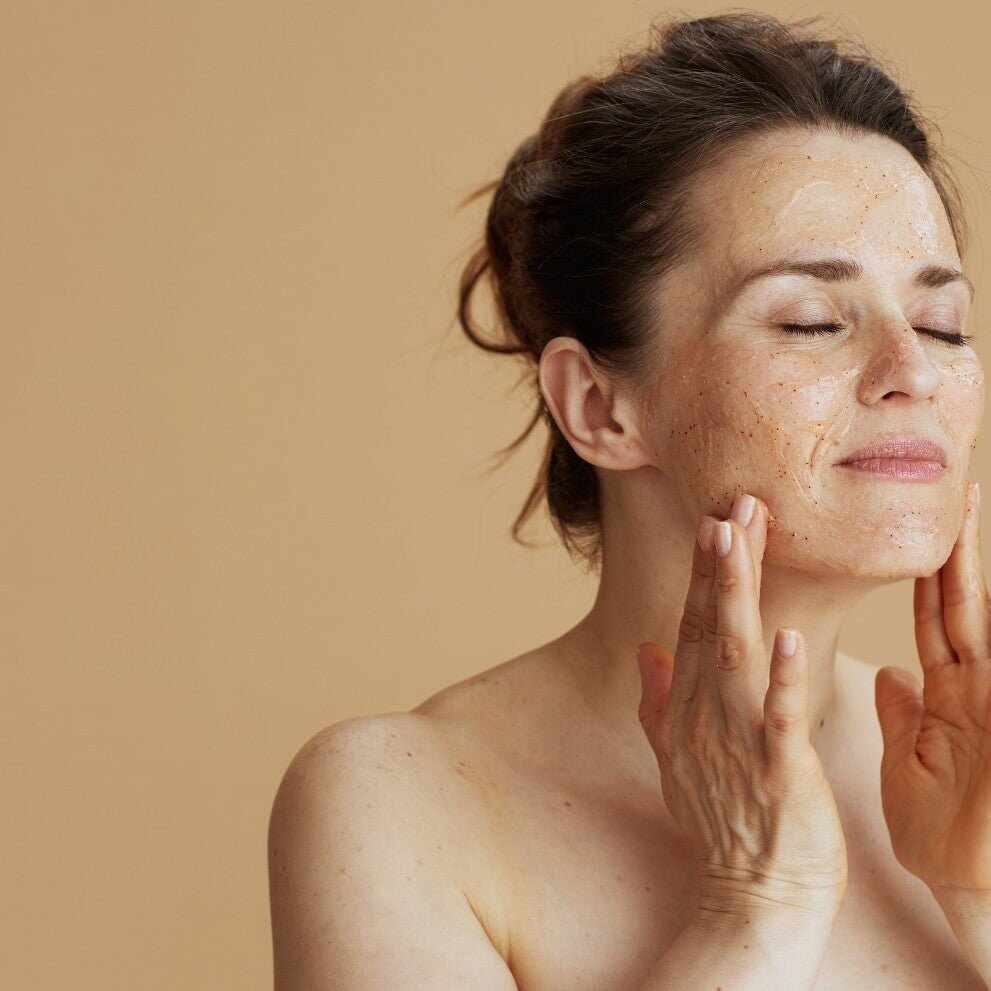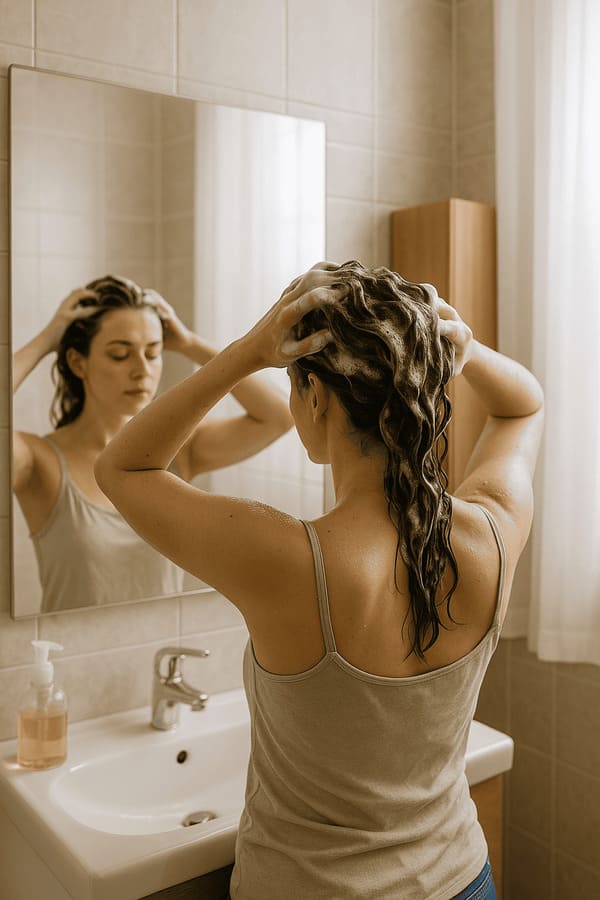Exfoliation plays an important role in a good skincare routine: it eliminates dead cells, helps your skin better absorb cosmetic active ingredients, and gives you a smoother, more luminous appearance.
I'm sure that when you hear the word exfoliation, the first thing that comes to mind is scrubs, but today I want to talk to you about chemical peels.
- Why exfoliate your skin?
- What are the differences between various chemical peels?
- Peeling with AHA
- Peeling with BHA
- Peeling with PHA
- Peeling with Enzymes
- How to best use chemical peels
Why exfoliate your skin?
The outermost layer of our skin, the stratum corneum, is made up mostly of dead cells; with exfoliation, we remove these dead cells, promoting skin regeneration processes.
Exfoliation can be done mechanically, using exfoliating gloves, natural fiber brushes, or the popular scrubs. Scrubs use exfoliating particles of varying sizes, such as salt, sugar, crushed nuts, and rice powder, which remove dead cells by rubbing them into the skin.
You can also exfoliate your skin with chemical peels , cosmetics that use acidic ingredients to remove dead cells through processes that weaken and break down the bonds that hold them together.
Unlike scrubs, however, the acids present in chemical peels can also act more deeply on the skin, treating blemishes such as wrinkles, blemishes, and enlarged pores.
What are the differences between various chemical peels?
Different types of acids, in different concentrations, can be used for chemical peels.
Be careful when choosing a product when looking at the percentage of acids it contains. In cosmetics, "more" doesn't always mean "better," and this is especially true for chemical peels.
Acids already work in very low percentages and treatments with a higher percentage of acid can only be performed by specialized medical personnel!
Peeling with PHA
Polyhydroxy acids are next-generation AHAs suitable for even the most sensitive skin. Their effectiveness is visible over the long term and they also have antioxidant and hydrating properties.
These acids are excellent for the most delicate skin but also as a valid anti-aging treatment since they neutralize the sources of oxidative stress, counteract collagen degradation and protect the skin barrier for more hydrated and elastic skin.
Gluconolactone and Lactobionic Acid are PHAs, essential in cell renewal, antioxidant and hydrating treatments.
Peeling with AHA
AHAs, Alpha Hydroxy Acids, are ingredients extracted from plants and fruits that remove the top layer of the skin, leaving it smoother, softer and more even.
They are also indicated for reducing dark spots, acne scars, reducing fine lines and enlarged pores and for improving skin texture.
The AHA includes:
- glycolic acid (extracted from sugar cane)
- mandelic acid (extracted from almonds)
- malic acid (extracted from apples)
- citric acid (extracted from citrus fruits)
- tartaric acid (extracted from grapes)
- lactic acid (from fermented sugar cane or beetroot)
These acids are suitable for all skin types, but as with all treatments, I always recommend testing the product before use on the crook of your elbow or behind your ear, especially if you have sensitive, delicate, or very reactive skin.
The most famous of all is certainly Glycolic Acid, indicated for acne-prone skin, wrinkles and blemishes.
Mandelic Acid is the gentlest of all, also ideal for dry and sensitive skin, rosacea and hyperpigmentation.
You can find Mandelic Acid and Gluconolactone in Yuniwa Cosmetics' exclusive AHA + PHA Peeling, a gel exfoliant formulated with a 20% AHA and PHA acid complex that works gently yet effectively on the skin.
Thanks to the synergy of these powerful active ingredients, it removes dead cells, stimulates cell renewal and promotes collagen production, revealing younger, brighter and more radiant skin.
Also suitable for sensitive skin, it does not contain photosensitizing active ingredients and can be used all year round.
Peeling with BHA
Beta hydroxy acids are fat-soluble acids and penetrate deeper than AHAs.
They are acids capable of superficially exfoliating the skin but also of dissolving sebum buildup, freeing the skin from impurities, blackheads, comedones and preventing ingrown hairs and milia.
They also have a mild anti-inflammatory action and therefore reduce inflammation caused by pimples.
BHAs are also suitable for all skin types, but are best suited for combination and oily skin.
Among the BHAs, the best known is Salicylic Acid , perfect for oily, combination, impure and acne-prone skin.
Caution: This ingredient is part of the same family as aspirin, so if you are allergic to aspirin, it is best to avoid it!
You can find Salicylic Acid in Purophi Rescue Lotion , a lotion that helps you even out your complexion and reduce impurities and imperfections.
Peeling with Enzymes
Extremely gentle and well-tolerated, there are fruit enzymes with keratolytic action such as Papain (extracted from papaya) and Bromelain (extracted from pineapple).
They are indicated for the chemical exfoliation of ultra-sensitive and delicate skin.
Miracle Glow is Essere Cosmetici's Enzyme Peeling , with an illuminating, exfoliating and smoothing action for all skin types, even the most sensitive.
Enriched with hyaluronic acid, it preserves skin's moisture balance, reducing blemishes and impurities. It soothes and restores the skin's barrier, protecting against free radicals.
How to best use chemical peels
Chemical exfoliation can help you get the skin you want, but it's important to pay attention to a few simple rules.
- Always do a small patch test before using a new product to assess your sensitivity to the product's ingredients.
- Don't overuse exfoliating products, as this can irritate your skin and cause blemishes.
- Do not use on broken, irritated or red skin and avoid using them after hair removal.
- Introduce acids gradually, even when using products designed for everyday use, such as cleansers or toners.
- Always remember to follow the manufacturer's recommended usage instructions and times, which you can find on the product packaging.
- Always exclude the eye contour and lip contour
- Apply them to cleansed, dry skin and wait at least 15/20 minutes before moving on to the next step of your skincare routine.
- Prefer using acids in your evening skincare routine, to help your skin regain its balance during your night's rest.
- Always use a moisturizer after exfoliating and remember to always use a sunscreen with UVA and UVB filters, with a high protection factor.
What does “chemical peel” mean and how does it work?
A chemical peel is a cosmetic treatment that uses acids (AHA, BHA, PHA) or enzymes to dissolve the bonds between dead cells in the stratum corneum, promoting cell renewal. Unlike mechanical scrubs, it also acts deeply, improving blemishes, enlarged pores, and skin texture.
Which type of chemical peel is right for me?
It depends on your skin type and what results you're looking for: if you have sensitive skin, PHAs or enzyme peels are better; for oily or acne-prone skin, BHAs (such as salicylic acid); for blemishes, pores, and fine lines, AHAs (glycolic, mandelic, lactic) can be effective.
How often can I use chemical peels?
For beginners or sensitive skin: once a week; for intermediate or professional users, with gentle products, you can increase to 2-3 times a week, always reporting any reactions. It's important to stay alert to your skin's signs.
What precautions should I take before and after a chemical peel?
Before: Patch test, clean skin, avoid use on broken or irritated skin. After: Do not use other mechanical or chemical exfoliants for at least 48 hours, moisturize, use strong sunscreen, and avoid perfumes or irritating cosmetics.
Are enzymes as effective as acids?
Enzymes (papain, bromelain, etc.) are less painful and gentler, ideal for those with sensitive or reactive skin. They don't always penetrate as deeply as stronger acids, but they offer gradual improvements with less risk of irritation. An excellent compromise.
Discover the complete section dedicated to skincare












